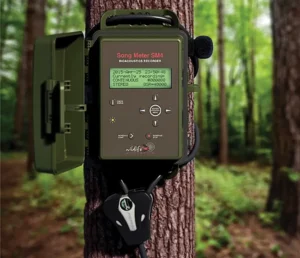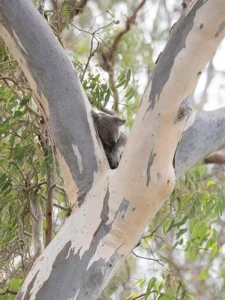The Koala is an icon of Australian nature, but these well-known tree-climbing marsupials can be hard to find. At Australian Wildlife Conservancy’s (AWC) Curramore Wildlife Sanctuary (also a Land for Wildlife property), incidental sightings, camera trap images and scats and scratches confirm that Koalas persist, but we don’t know much more.
Spending most of their time motionless high in the canopy, Koalas pose a real challenge for ecologists monitoring them, especially across the steep terrains of Curramore. Now, a new approach that relies on the Koalas’ repertoire of growls, grunts and barks offers the prospect of unlocking important data essential to the protection of this endangered species.

For most animal species, conventional survey methods that use baited cage traps or camera traps are an effective means of surveying at scale. However, given Koalas spend most of their time off the ground and are not attracted to food bait, these techniques are not effective. In the past, ecologists have explored other methods to survey at scale, including spotlighting transects and working with specially trained detection dogs that sniff out fresh scat and the scent of animals up above. In 2021, four individual Koalas were observed during spotlighting transects across Curramore, which was identified as a Koala Priority Area by the Queensland Government in 2020. Detection dog surveys also picked up an increase in Koala activity on the property from 2015 to 2022.
While these surveys offer an intriguing glimpse into Koalas on Curramore, the picture remains incomplete. The AWC team is eager to establish better understanding of the distribution and population density of Curramore’s resident Koalas, and to investigate any threats.
Thanks to a generous contribution from the federal government’s Koala Conservation and Protection Grant, AWC is hoping to learn a lot more about its Koala populations by deploying bioacoustic monitors across suitable Koala habitat at Curramore. By high-tech ‘listening’, ecologists hope to conduct larger-scale monitoring of the species and establish baseline data about the presence and abundance of Koalas on the sanctuary. Ecologists will also use thermal drone surveys and compare the effectiveness of both technologies.
 Andrew Howe, AWC Senior Field Ecologist who is leading the bioacoustic research at Curramore, said that although Koalas are a famous Australian species, very little is known about their ecology, distribution and threats in the northern extent of their range.
Andrew Howe, AWC Senior Field Ecologist who is leading the bioacoustic research at Curramore, said that although Koalas are a famous Australian species, very little is known about their ecology, distribution and threats in the northern extent of their range.
“Curramore Wildlife Sanctuary is the largest nature refuge on the Sunshine Coast and is a geographically significant habitat corridor linking habitat from Maleny National Park in the west to other nature refuges and Koala habitat in the east,” Andrew explained.
“The sanctuary could potentially sustain an important population in the context of the broader region – but we need to do research to better understand local population dynamics.”
In addition to monitoring Koalas on Curramore, AWC has also partnered with community-led organisation Barung Landcare to restore vital Koala habitat on five hectares of cleared land (referred to as “Claire Reserve”, thanks to a generous donation by Stephanie Hicks – see article on facing page). Barung Landcare supplied local Koala feed trees and they were planted by Barung and AWC staff with the help of volunteers.
AWC will continue with the removal of lantana from priority areas across the sanctuary. Over the last decade, AWC has removed more than 50% of lantana from Curramore, with some patches being over 3-4 metres in height. Together, these initiatives will help make the 196 hectares of land at Curramore a safe haven for the iconic Koala.
Article by Genevieve Deaconos, Development Manager
Andrew Howe, Senior Field Ecologist and
Nahrain John, Communications Associate
Australian Wildlife Conservancy
